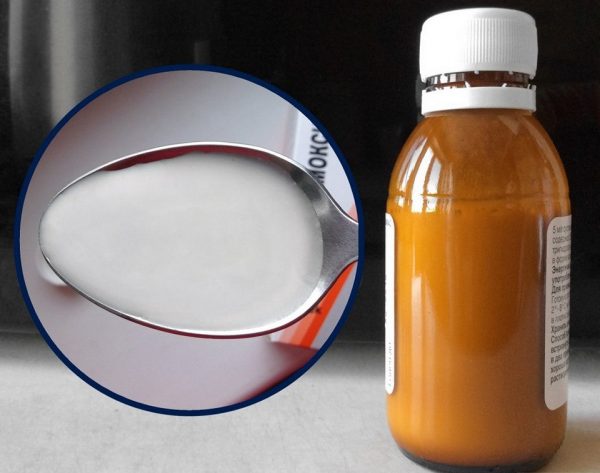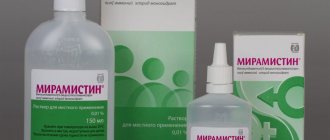During lactation, a woman needs to take care of everything she consumes, since many substances pass into breast milk and can affect the baby. It is especially difficult for young mothers when health problems arise that require antibiotics. Many of them cannot be taken while breastfeeding your baby. Doctors call the drug Amoxiclav safe during breastfeeding. However, it should be taken when feeding a baby with breast milk only after consulting a doctor.
Is it possible to use Amoxiclav while breastfeeding?
The instructions for using the drug do not prohibit taking Amoxiclav during breastfeeding. At the same time, a nursing mother must strictly adhere to the recommendations for the dosage and dosage regimen of the drug in order to avoid negative consequences for the newborn. The conditions for taking Amoxiclav during breastfeeding, although slightly, differ from the standard ones.
It is advisable to take an antibiotic while breastfeeding only if there are serious indications. It is often prescribed for inflammatory diseases that cannot be eliminated without antibiotics: pneumonia, cystitis and other ailments caused by bacterial activity. It is also recommended to use Amoxiclav for bacterial inflammations, when it is important for the mother to avoid infection or cessation of lactation. Most often, the drug is prescribed for mastitis that occurs due to hypothermia or stagnation of milk when the baby is rarely fed breast milk and there is no pumping.
Important! If you have mastitis while breastfeeding, the reason for taking medication is to prevent the formation of an abscess in the mammary gland.
Recommendations on how to take Amoxiclav can be obtained from your doctor. This is the most optimal option, since the specialist will take into account the characteristics of the female body, the age of the child and the intensity of feeding (for example, if the mother has the opportunity to replace feeding the child with breast milk with complementary foods). In any case, before starting to take Amoxiclav when feeding a baby with breast milk, all negative consequences, including allergic reactions in the baby, are taken into account.
Opinion of manufacturers and doctors
Manufacturers conducted a large-scale study of the drug. They claim that Amoxiclav can be used during lactation.
Doctors believe that Amoxiclav and breastfeeding are compatible things.
If the dosage is observed, nothing bad will happen to the child; the drug is relatively safe for the baby. A woman should not stop breastfeeding, since the antibiotic is prescribed for a short course, and human milk is an invaluable product that cannot be replaced by anything.
How does Amoxiclav work?
The original description and instructions for use of the drug classify Amoxiclav as a semi-synthetic antibiotic of the penicillin group. The list of active ingredients of the product mentions two substances:
- The semisynthetic antibiotic amoxicillin is the main active ingredient that inhibits bacteria and destroys their membranes.
- Clavulanic acid is an additional bactericidal component that enhances the effectiveness of the drug against beta-lactam bacteria.
The product is effective against many microorganisms. Each component of Amoxiclav is able to penetrate biological fluids and soft tissues within an hour and a half after taking the tablets. When using Amoxiclav in the form of a suspension, active compounds are detected in breast milk even faster - after 30-45 minutes.
In favor of prescribing Amoxiclav during lactation is the fact that the active substances are quickly eliminated from the body through the kidneys and intestines. This means that after completing the course of therapy, you can resume feeding after 12 hours. However, the instructions for use allow nursing mothers to continue breastfeeding without the risk of intoxication. This is important, since in case of mastitis, it is necessary for a nursing mother to maintain lactation during breastfeeding, especially if the baby is not yet 6 months old.
How to take Amoxiclav
The dosage for nursing mothers is selected by the doctor depending on the form and severity of the disease. The functional state of the kidneys and liver, concomitant diseases, and the presence of an allergic background are taken into account.
For moderate infections, Amoxiclav 250 is prescribed, where the content of active substances is minimal. The medicine is taken 1 tablet every 8 hours. The doctor may recommend the drug Amoxiclav 500, then the order of administration is as follows: 1 tablet every 12 hours. If a suspension is used, then 1 tablet corresponds to 5 ml of liquid form.
Amoxiclav 250 – 1 tablet 3 times a day; Amoxiclav 500 – 1 tablet 2 times a day.
Severe infections with high fever require higher dosages of antibiotics. In this case, switch to Amoxiclav 825 or intravenous suspension. The duration of taking the medicine varies from 3 to 14 days and is determined by the doctor.
Expert opinion
Sokolova L. S.
Pediatrician of the highest category
You cannot arbitrarily shorten the course of treatment or limit yourself to a single dose of medication. Even with a mild form of the disease, this should not be done. Independent withdrawal of the drug will lead to ineffective therapy and increase the duration of the disease.
How to reduce side effects?
For nursing mothers there are special instructions on how to take the drug. The concentration of the active substance in the blood plasma reaches its maximum level one hour after taking Amoxiclav.
To prevent the medicine from affecting the child, it is recommended to drink it immediately before or during feeding. Then, before the next feeding, the main part of the antibiotic will have time to be eliminated from the body, and only a small amount of the drug will penetrate into the milk.
To prevent the development of intestinal dysbiosis, a woman is recommended to take one of the approved probiotics during treatment with Amoxiclav:
- Lactobacterin;
- Bifiform;
- Acipol;
- Enterol.
The baby can also (as prescribed by the pediatrician) be given Bifiform Baby or Rotabiotic Baby, which are ideal for newborns.
For cystitis
There is a form of the disease known as postpartum cystitis. Inflammation of the bladder occurs for the following reasons:
- the bladder becomes sandwiched between the pelvic bones and the baby’s head, which leads to disruption of its blood supply;
- after childbirth, a woman is given ice on her lower abdomen, which provokes inflammation of the bladder;
- defenses decrease, the body weakens after childbirth.
Amoxiclav for cystitis is an effective drug because it is active against many microorganisms that cause infection. The medicine is prescribed as a tablet every 6-8 hours 3-4 times a day. The course of treatment is continued for 5-14 days.
For mastitis
An advanced form of the disease can result in a purulent process and abscess formation. In this case, it is difficult to avoid surgery. Amoxiclav is used to prevent complications. The dosage depends on the clinical picture.
In severe cases of the disease - 1 tablet 875+125 mg 2 times a day or 1 tablet 500+125 mg 3 times a day.
The use of an antibiotic significantly improves a woman’s condition, relieves inflammation, pain, and swelling. The outflow of breast milk is normalized, and “bumps” in the mammary gland disappear. It is not recommended to stop breastfeeding while taking the medicine; on the contrary, with its help recovery occurs faster. For mastitis, the baby is given both breasts alternately.
Indications for use of Amoxiclav during breastfeeding
Women's health is somewhat weakened after childbirth, so bacterial infections often increase during breastfeeding. In this case, it is recommended that a nursing mother be treated with safe antibiotics that either do not penetrate into the breast tissue or do not have a significant effect on the baby when breastfed.
The use of Amoxiclav during feeding is effective and safe when using any dosage form. Its active components help eliminate inflammation caused by the activity of bacteria susceptible to penicillins. Lactating women are prescribed medicine for the following diseases:
- inflammatory processes of ENT organs;
- inflammatory processes of the bronchopulmonary system;
- inflammatory diseases of the urinary system;
- inflammatory and purulent diseases of the skin, joints and bones;
- gynecological and infectious sexual pathologies.
Also, the development of inflammatory diseases occurs due to changes in the body. For example, antibiotics are prescribed for lactostasis (milk stagnation) during breastfeeding, which threatens to develop into mastitis. If a similar condition was observed after a previous birth, the patient will be advised to use massage, frequent feeding or expressing milk during lactation.
Note! Despite the proven safety of the drug, only a doctor has the right to prescribe the antibiotic itself and determine its dosage for lactostasis, bronchitis, and cystitis for nursing mothers.
About the drug
"Amoxiclav" refers to antibacterial drugs. It cannot be called new; it has been used in medicine for quite a long time, which has made it possible to thoroughly study the mechanism of its action and its effect on different systems of the body.
The drug includes several substances. The main one is semi-synthetic penicillin (amoxicillin). The function of its conductor is performed by clavulanic acid, which prevents microorganisms - the sources of the disease - from using their defense mechanisms. Due to this, the main active ingredient can easily destroy the source of inflammation.
How to drink Amoxiclav
It is recommended to take Amoxiclav while breastfeeding your baby in the shortest possible course. The doctor selects the minimum effective dosage, based on the patient’s complaints and diagnostic results. Most often, to eliminate unpleasant symptoms during breastfeeding, taking Amoxiclav three times with an interval of 8 hours is sufficient. If necessary, increase the dosage and increase the interval between doses to 12 hours.
Since the components of the drug in maximum concentration are observed in milk 1.5-2 hours after taking the tablets or suspension, you need to use the product so that the peak of this indicator occurs after feeding. To do this, drink the tablets or suspension at least 30-40 minutes before putting the baby to the breast. As a rule, by the next feeding the concentration of active substances in breast milk decreases.
Advice! When using antibiotics, a woman with breastfeeding is advised to drink more so that the kidneys more actively remove the medicine from the body.
Tendency to intolerance
It is important before you start taking it to consult your doctor about using Amoxiclav while breastfeeding. The consequences for the baby and his mother may be more likely to be negative in some cases:
- The woman is allergic to the components of the antibiotic.
- The child has a tendency to exhibit allergic reactions. This may be a hereditary problem that could be passed on to the baby. Or when there have already been cases of allergies.
- The woman or her baby has liver or kidney problems.
Dosages of Amoxiclav for nursing mothers
The standard dosage of Amoxiclav tablets or suspension when feeding with breast milk is 125 mg per dose. A woman is allowed to drink no more than 2 tablets per day. If no pronounced reactions to the drug are observed, but the symptoms are severe, the single dose is increased to 250 mg.
As for cases where the disease is severe, the instructions for lactation allow for an even greater increase in the single dose to 500 mg, and the interval between doses is increased to 12 hours. For mastitis with or without suppuration, the drug is taken for at least 2 weeks, 500 mg three times a day, and for complicated cases, 875 mg three times a day.
The duration of the course and other features of taking Amoxiclav are discussed individually. So, for cystitis, a 5-day course of treatment is sufficient, while for sore throat and mastitis, the dose of antibiotic prescribed by the doctor should be taken for at least 10-14 days.
Important! To prevent changes in the intestinal microflora in the mother, you should start taking Bifiform, Linex, Hilak Forte and their analogues along with the antibiotic.
Composition, therapeutic effect
Amoxiclav consists of amoxicillin and clavulanic acid. Amoxicillin is a type of semisynthetic antibiotic of the penicillin group. The substance destroys the cellular structures of bacteria during their growth and reproduction. This antibiotic is active against a wide group of pathogenic microorganisms: staphylococci, streptococci, gonococci, meningococci, E. coli, Shigella and salmonella. Amcocillin is consistently included in the WHO list of most important medicines. Due to the fact that amoxicillin is easily destroyed by the enzymes of some bacteria, clavulanic acid was added to it, which neutralizes this destructive effect. In addition, clavulanic acid itself exhibits high activity against atypical bacteria.
Amoxiclav is available in the form of tablets, powder for suspension, and powder for injection. For a nursing woman, doctors recommend using the first two forms. It is important to know that the types of tablets offered differ in the ratio of components. Therefore, you should select the form of the drug and its dosage in collaboration with your doctor. You can choose from the following types of antibiotic:
- Amoxiclav 125 is a powder for syrup. 5 ml contains the following amounts of amoxicillin and clavulanic acid: 125 mg and 31.5 mg. One package contains 100 ml of the drug.
- Amoxiclav 250 is a powder for syrup. 5 ml contains double the amount of active ingredients: 250 mg and 62.5 mg. These tablets are called "Amoxiclav Forte".
- Amoxiclav 500 is a tablet form containing: amoxicillin (500 mg), acid (125 mg).
- Amoxiclav 875 - tablets (875/125 mg).
- Quiktab is a fast-acting tablet of two types: 500/125 mg, 875/125 mg.
Release forms in the photo

Tablets are the most common form of Amoxiclav for adults.

Amoxiclav powder is used to prepare a medicinal suspension

Kviktab are instant tablets
Consequences for the child
When taken correctly, the drug is quickly eliminated from the body, so its active compounds do not have time to have a negative effect on the baby’s body. However, despite this, sometimes there are unpleasant consequences for the child, which are typical for antibiotics. Among them:
- thrush in the mouth;
- dermatitis and allergies;
- discomfort in the intestines.
In order to promptly identify side effects in your baby, it is important to monitor his condition and mood. Frequent crying, pulling the legs towards the stomach, rumbling and diarrhea should alert you and be a reason for a visit to the pediatrician. Children's medications to restore microflora help eliminate these symptoms.
When allergic reactions occur, the child may become anxious due to itching of the skin, swelling of the nasal mucosa, and so on. Upon careful examination, red rashes or even papules may be found on the body. In this case, you need to consult a pediatrician or dermatologist, who can prescribe external medications or children's allergy drops/sprays.
As numerous reviews indicate, the antibiotic Amoxiclav quickly copes with infections in the body of a nursing mother. Fears for the baby’s condition are often unfounded, since the risk of side effects when taken correctly is extremely low.
Indications
- lactation mastitis;
- urinary tract infections and cystitis;
- gynecological diseases;
- infection of the upper respiratory tract: sore throat, sinusitis, pneumonia or otitis media;
- gonorrhea;
- infectious suppuration of wounds;
- prevention of purulent processes after surgery.
The effectiveness of the drug in the fight against the following bacteria has been scientifically proven: Shigella, streptococci, listeria, peptococci, influenza and enterococci. Amoxiclav also fights well against salmonella, clostridia, moraxella and other pathogens.
The drug has gained popularity due to its fast action and high efficiency. Improvement in well-being is often observed within an hour after taking the medicine.











